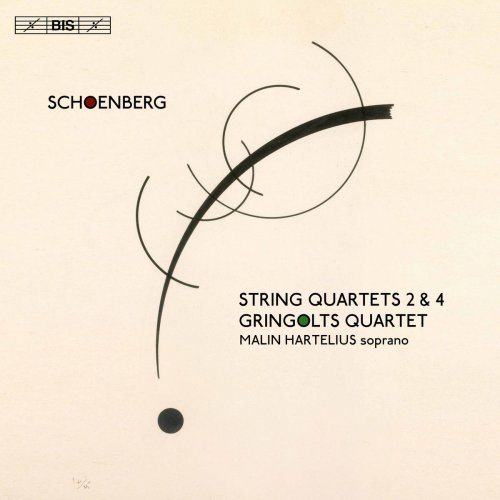
Malin Hartelius & Gringolts Quartet - Schoenberg: String Quartets Nos. 2 & 4 (2017)
BAND/ARTIST: Malin Hartelius, Gringolts Quartet
- Title: Schoenberg: String Quartets Nos. 2 & 4
- Year Of Release: 2017
- Label: BIS
- Genre: Classical
- Quality: flac lossless
- Total Time: 01:04:59
- Total Size: 273 mb
- WebSite: Album Preview
Tracklist
---------
01. String Quartet No. 2, Op. 10: I. Mäßig - Malin Hartelius
02. String Quartet No. 2, Op. 10: II. Sehr rasch - Malin Hartelius
03. String Quartet No. 2, Op. 10: III. Litanei - Malin Hartelius
04. String Quartet No. 2, Op. 10: IV. Entrückung - Malin Hartelius
05. String Quartet No. 4, Op. 37: I. Allegro molto, energico - Gringolts Quartet
06. String Quartet No. 4, Op. 37: II. Comodo - Gringolts Quartet
07. String Quartet No. 4, Op. 37: III. Largo - Gringolts Quartet
08. String Quartet No. 4, Op. 37: IV. Allegro-Agitato - Gringolts Quartet
Conceived thirty years apart, both works on the present disc came into being at difficult times in the life of Arnold Schoenberg. Emotional stress caused by a marital crisis around 1907-1908 is often claimed to have contributed to the break with tonality that the Second String Quartet represents – in the course of the work Schoenberg moves from the post-Wagnerian chromaticism of Late Romanticism to atonality, with the final movement lacking a key signature altogether. Another unusual feature is the inclusion of a soprano in the two last movements. Schoenberg himself later wrote: 'I was inspired by poems of Stefan George, the German poet ... and, surprisingly, without any expectation on my part, these songs showed a style quite different from everything I had written before.'
Almost thirty years later, in 1936, the String Quartet No. 4 was one of the first works that Schoenberg composed in the U.S.A. after having been forced into exile by the threat of the Nazi regime in Germany. He had left Europe in 1933, but the first years in his new home country had been taxing, with health problems and a difficult work schedule involving teaching in both Boston and New York. If the second quartet is a key work of musical modernism, pointing towards an as yet unknown future, String Quartet No. 4 rests securely on the principles of twelve-tone composition that Schoenberg had developed during the intervening years – but makes use of these principles in a somewhat freer, more relaxed manner than his previous twelve-tone works. The two works are given full-blooded performances by the Gringolts Quartet, joined by the Swedish soprano Malin Hartelius in the Second String Quartet.
Hi-Res version
---------
01. String Quartet No. 2, Op. 10: I. Mäßig - Malin Hartelius
02. String Quartet No. 2, Op. 10: II. Sehr rasch - Malin Hartelius
03. String Quartet No. 2, Op. 10: III. Litanei - Malin Hartelius
04. String Quartet No. 2, Op. 10: IV. Entrückung - Malin Hartelius
05. String Quartet No. 4, Op. 37: I. Allegro molto, energico - Gringolts Quartet
06. String Quartet No. 4, Op. 37: II. Comodo - Gringolts Quartet
07. String Quartet No. 4, Op. 37: III. Largo - Gringolts Quartet
08. String Quartet No. 4, Op. 37: IV. Allegro-Agitato - Gringolts Quartet
Conceived thirty years apart, both works on the present disc came into being at difficult times in the life of Arnold Schoenberg. Emotional stress caused by a marital crisis around 1907-1908 is often claimed to have contributed to the break with tonality that the Second String Quartet represents – in the course of the work Schoenberg moves from the post-Wagnerian chromaticism of Late Romanticism to atonality, with the final movement lacking a key signature altogether. Another unusual feature is the inclusion of a soprano in the two last movements. Schoenberg himself later wrote: 'I was inspired by poems of Stefan George, the German poet ... and, surprisingly, without any expectation on my part, these songs showed a style quite different from everything I had written before.'
Almost thirty years later, in 1936, the String Quartet No. 4 was one of the first works that Schoenberg composed in the U.S.A. after having been forced into exile by the threat of the Nazi regime in Germany. He had left Europe in 1933, but the first years in his new home country had been taxing, with health problems and a difficult work schedule involving teaching in both Boston and New York. If the second quartet is a key work of musical modernism, pointing towards an as yet unknown future, String Quartet No. 4 rests securely on the principles of twelve-tone composition that Schoenberg had developed during the intervening years – but makes use of these principles in a somewhat freer, more relaxed manner than his previous twelve-tone works. The two works are given full-blooded performances by the Gringolts Quartet, joined by the Swedish soprano Malin Hartelius in the Second String Quartet.
Hi-Res version
Year 2017 | Classical | FLAC / APE
As a ISRA.CLOUD's PREMIUM member you will have the following benefits:
- Unlimited high speed downloads
- Download directly without waiting time
- Unlimited parallel downloads
- Support for download accelerators
- No advertising
- Resume broken downloads


